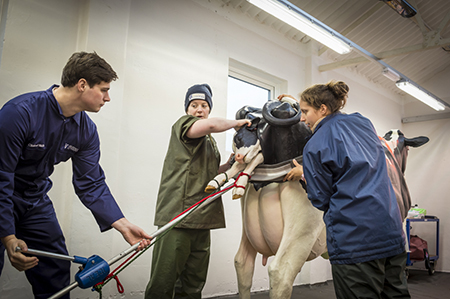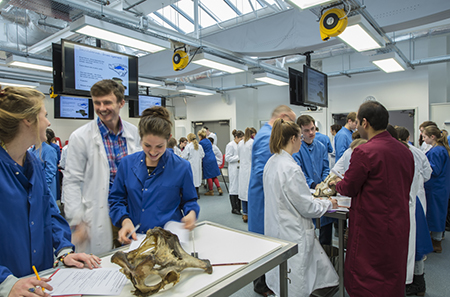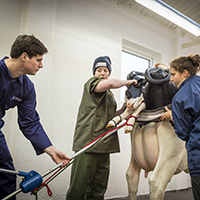 The cow laboratory allows students to practice techniques in a realistic but low risk environment
The cow laboratory allows students to practice techniques in a realistic but low risk environment
The University’s School of Veterinary Science is introducing a new curriculum to further enhance undergraduate veterinary teaching and learning.
The curriculum, developed through consultation with staff, current and past students, and other key stakeholders, will provide world-leading clinical training, underpinned with the latest scientific knowledge.
The review also included exploring new ways of teaching in order to reduce the number of lectures in favour of more dynamic forms of training, such as ‘scenario’ sessions where students work in groups to tackle clinical problems.
Integrate subjects
Dr Alex German, programme director for the new curriculum, explains: “Instead of a modular format, where subjects are taught in self-contained units, we now integrate subjects throughout the degree programme so that students can seamlessly connect what they have learnt to what they are practising.
“Pre-clinical subjects are taught early on, but then revisited during the later stages of the course to ensure that clinical knowledge is based on sound physiological and pathophysiological principles.”
Fundamental research skills, such as basic statistics and scientific writing, are taught in the early years, and then reinforced when students undertake a full honours-degree-equivalent research project in their third year.
Evidence-based veterinary medicine principles also underpin all clinical subjects, enabling undergraduates to review clinical evidence critically, and appraise new data as it emerges.
 New purpose built teaching laboratories are up and running
New purpose built teaching laboratories are up and running
The most significant changes, however, focus on the teaching of clinical skills, which is now taught throughout the five-year programme. To support this, the School has appointed a number of new lecturers specifically to teach clinical skills, and opened new purpose-built teaching laboratories.
Teaching includes the use of models such as a cattle obstetric simulator, a life size model of a horse with foam pads for practising injections, and a ‘Lambinator’ for lambing practise. Many of the models have been designed and built by the new lecturers.
A ‘cow laboratory’ has also been developed to provide an area for self-directed teaching where students can practise skills such as, haltering and casting a cow, learning how to cast a calf`s leg, and perform rectal examination with the use of ‘Betsy’, the in-house reproductive tract simulator.
Improving lives
Dr Alison Reid, clinical skills lecturer, said: “When I qualified 10 years ago, I could not confidently perform some of the skills we are now teaching our first year students and I remember how unnerving that was when I first entered practice.
“If we can take away the difficulty associated with performing unfamiliar manual skills under pressure, we will be improving the lives of our graduates, their colleagues and their patients.”
The School has recently topped the league table for veterinary science in the Guardian’s 2015 University Guide.
For more information about study at the School of Veterinary Sciences, visit: http://www.liv.ac.uk/veterinary-science/
